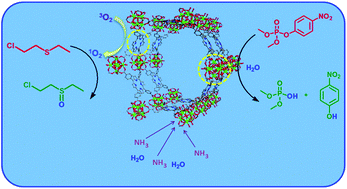Metal–organic frameworks for the removal of toxic industrial chemicals and chemical warfare agents
Abstract
Owing to the vast diversity of linkers, nodes, and topologies, metal–organic frameworks can be tailored for specific tasks, such as chemical separations or catalysis. Accordingly, these materials have attracted significant interest for capture and/or detoxification of toxic industrial chemicals and chemical warfare agents. In this paper, we review recent experimental and computational work pertaining to the capture of several industrially-relevant toxic chemicals, including NH3, SO2, NO2, H2S, and some volatile organic compounds, with particular emphasis on the challenging issue of designing materials that selectively adsorb these chemicals in the presence of water. We also examine recent research on the capture and catalytic degradation of chemical warfare agents such as sarin and sulfur mustard using metal–organic frameworks.

- This article is part of the themed collection: Metal-organic frameworks and porous polymers – current and future challenges


 Please wait while we load your content...
Please wait while we load your content...